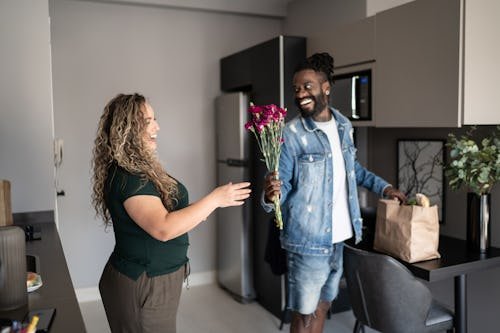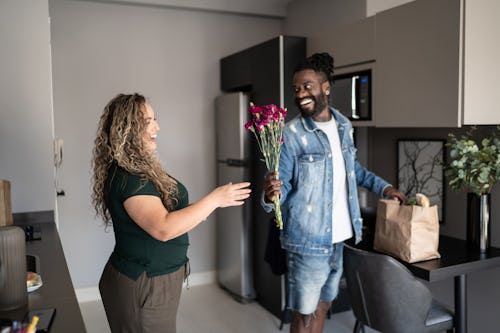

I’ve been single for a long time, and while I’d like to share my life with someone, the idea of sharing my space with anyone other than my cat makes me a little antsy. It’s not that I don’t want a partner — that’s different. But the thought of truly merging lives and being part of each other’s day-to-day, all day, forever? That feels a little claustrophobic.
Luckily, we live in an era in which “living together apart (LAT)” is a thing. And, admittedly, the idea that having a successful relationship doesn’t have to mean arguing over closet space or whose turn it is to buy toilet paper is pretty refreshing.
Even celebrities are embracing the LAT trend. Gwyneth Paltrow and Brad Falchuk waited a year after marrying to move in together, with Paltrow crediting the space for keeping mystery alive and “preserving the idea that this person has their own life.” Gillian Anderson has said living apart strengthens her relationship. “My partner and I don’t live together. If we did, that would be the end of us. It works so well as it is — it feels so special when we do come together,” she said.
It’s not just celebs loving their unique living situation. In fact, a 2020 study suggested that more couples than ever are choosing to live apart, and that was before the COVID-19 pandemic. According to the United States Census Bureau, 3.89 million Americans are living in separate quarters from their spouses (which makes up 2.95 percent of all U.S. marriages)
But let’s be clear: LAT is different from a LDR (long-distance relationship).
“Living apart together is an intentional choice to reside separately, be it different rooms or different houses, while maintaining a chosen, committed relationship. Though it may sound a lot like a long-distance relationship, the key difference is that it is not a result of external influences, and they would live together if they could,” Reesa Morala, a licensed marriage and family therapist, and founder of Embrace Renewal, explains. “Similarly with dating, these couples generally have made a commitment to be with each other and share their life with each other. They are not in the ‘testing the waters out’ phase, still. They know they want to be with this person.”
Licensed marriage and family therapist Steevy Griffin, owner of Haus of Therapy, is in her own LAT relationship. For her, it comes down to rewriting the script as to what relationships can be like and not what they should be like. “Modern relationships just mean shedding these heteronormative standards of what we were taught relationships should look like, and doing whatever works for us,” she explains. “It’s about prioritizing individual needs and shared values over societal expectations, and creating a partnership that’s authentic to the people in it — not one that simply adheres to outdated rules. It requires a willingness to unlearn what we’ve been taught and consciously build a new kind of connection.”
In other words, LAT isn’t actually creating distance with you and your partner; it’s about redefining closeness.
Curious about this trend? We talked to experts to learn more about what it means to sustain a relationship together while living apart.
How do you figure out if LAT is something you want?
For Griffin and her partner, the choice to live apart was a proactive decision driven by a few key factors. “The most immediate was the significant difference in our daily work schedules,” she says. “Beyond that, living in New York City’s small spaces made it clear that co-existing in close quarters was creating unnecessary friction.”
She says they realized that their relationship thrives when they prioritize three core values: autonomy, individuality, and independence. “Maintaining separate living spaces allows us to have personal freedom and our own rhythm, which in turn makes us more fulfilled and, ultimately, better partners to one another,” she says.
Griffin adds that this model has also helped them shift their focus to quality over quantity. “Our time together is intentional and meaningful because it isn’t just a byproduct of shared living,” she says. “We have dedicated date nights, shared meals, and travel together, but we also have our own spaces to recharge and pursue individual interests.”
Morala says, from her experience, the kinds of couples or personalities that tend to thrive in LAT relationships are ones that have:
- A secure attachment with one another
- Have a similarly weighted value on connection and independence
- Are not prone to jealousy
- Feel confident and committed to the work to intentionally invest in the relationship
How do you start the conversation with your partner about an LAT?
According to Morala, the best way for a couple to bring up the idea of LAT and explore whether it’s right for them is by asking themselves these three questions:
- Do I want to do this because it’s trying to bandage a deeper-rooted issue?
- Is this appealing to me because I want to be able to have other relationships without them knowing and without owning up to that want?
- Would this be a move that is purely self-serving?
“If you answered yes to any of these, I’d get curious and explore those ideas first,” she says. “If the true answer is no to them, then you’re ready to set the stage. Make sure that you are both in the headspace to approach each other with openness. Start from a place of loving words of affirmation that help remind your partner that you want to be collaborative and you are talking as a team, not an individual. And remember to speak and listen from a place of trying to understand, not to convince the other person or respond to prove a point. Then have fun and get creative in exploring!”
Griffin’s first piece of advice for any couple curious about LTA is to get radically curious about your relationship. “This means moving beyond the societal script and taking a deep, honest look at what you both truly value, what you need to thrive, and what might be lacking in your current arrangement,” she explains. “This self-exploration can be challenging, so I highly recommend couples or individual therapy.” Griffin says a facilitated conversation in an emotionally safe environment can help you explore questions like:
- What are our individual needs for independence and personal space?
- How do we feel about our current living situation? Is it a source of stress or comfort?
- What are our long-term goals, both individually and as a couple?
What key agreements or boundaries should couples discuss before committing to LAT?
When it comes to dealing with the practicalities of a LAT, Morala says couples should come to the table “with a list of areas of flexibility and less flexibility in broaching this lifestyle. Make sure that you’re really keeping it aligned with each of your individual core values and your family core values.” She suggests the following key topics to consider.
Finances
Is it shared/separate? Would it be helpful to have a scheduled financial check-in once a month?
Exclusivity
Are you remaining exclusive with one another? Are you consciously deciding to open the relationship?
Connection
How are we going to be intentional in our relationship with one another? How are we going to remain sexually connected? How are we going to remain emotionally connected? How are we going to make sure that the physical distance doesn’t lead to sexual or emotional distance? When will we spend time with one another?
Children
If there are children in the picture, it’s important to discuss and consider the impact on their well-being. How can we ensure they feel stable and connected? How will we ensure their physical, social, and emotional needs are met?
External Opinions
How do you want to handle others pushing back on the choice that you are making?
For Griffin, making LAT work means you and your partner navigate boundaries, both emotional and physical, in a way that fits your relationship. “The most difficult part about boundaries can be identifying them in the first place — like a lot of people, we are new to this and navigating a new space,” she says. “This requires trial and error, learning what works for us, and communicating about the things we have noticed.”
Her non-negotiables include regular check-ins and surfacing issues before they become resentments. “Because a main reason for our LAT is to promote autonomy, respecting each other’s need for alone time and separate social lives is a core pillar,” she explains. “Avoiding rigidity in a schedule and maintaining flexibility when needed is also important.”
So, how do you deal with external criticism and stigma that LATs aren’t complete relationships?
Morala advises couples to respond to outside criticism with: “We’ve made a thoughtful decision and would appreciate the same respect we’re offering you.” Repeat as needed, she says, adding, “Remember you don’t owe anyone an explanation.”
For Griffin, at least, maintaining intimacy and closeness in a LAT has strengthened her relationship.
“There’s a reason the phrase ‘distance makes the heart grow fonder’ exists,” she says. “The physical separation has actually forced us to be more intentional about maintaining intimacy and closeness. We’ve shifted from passive connection—simply co-existing in the same space—to active, deliberate efforts to connect. We alternate planning date days and nights, keep a shared Google list of restaurants and bars to try, and try to reserve Sundays for ‘us.’ I can confidently say we genuinely enjoy each other’s company more.”


